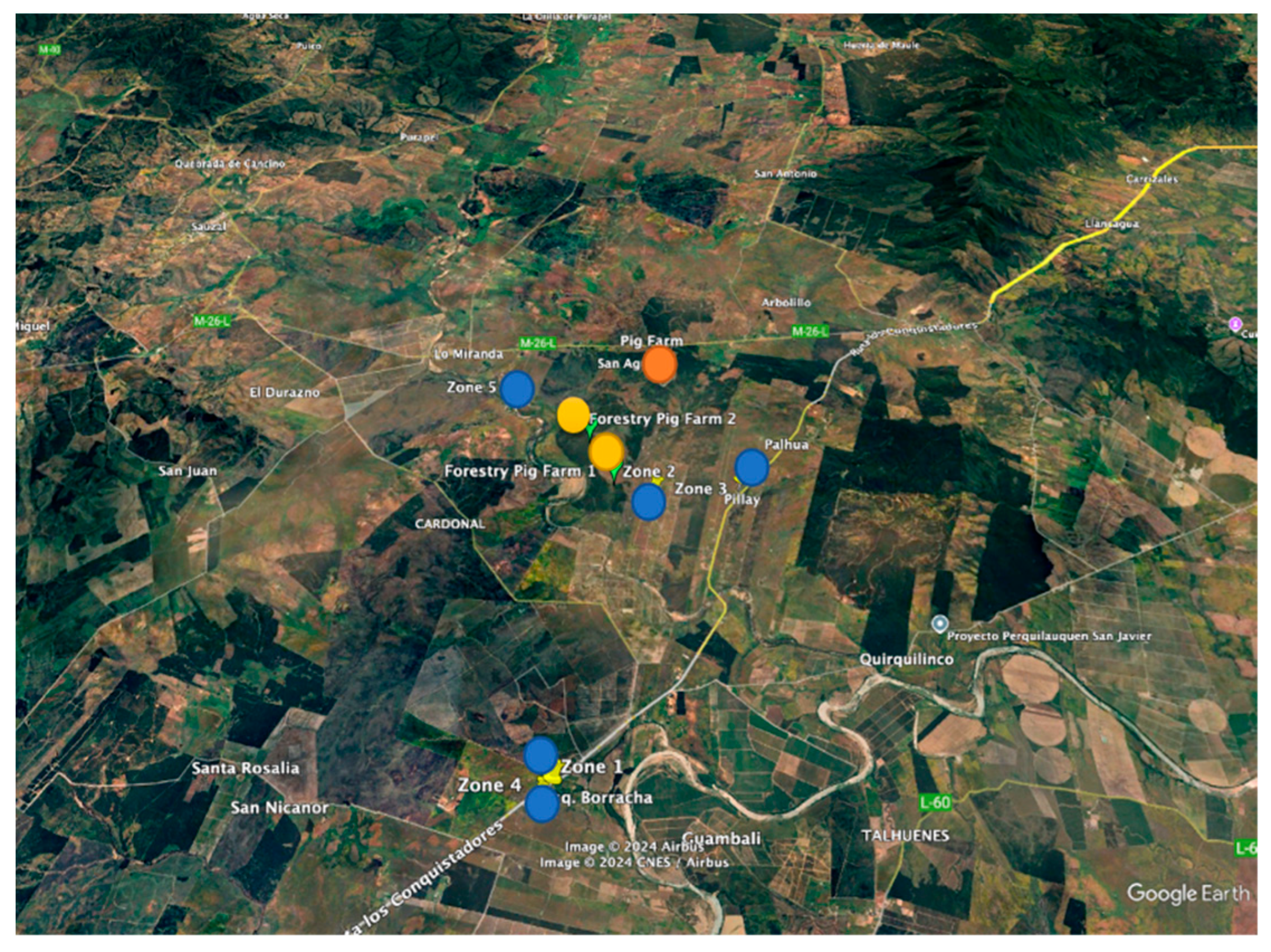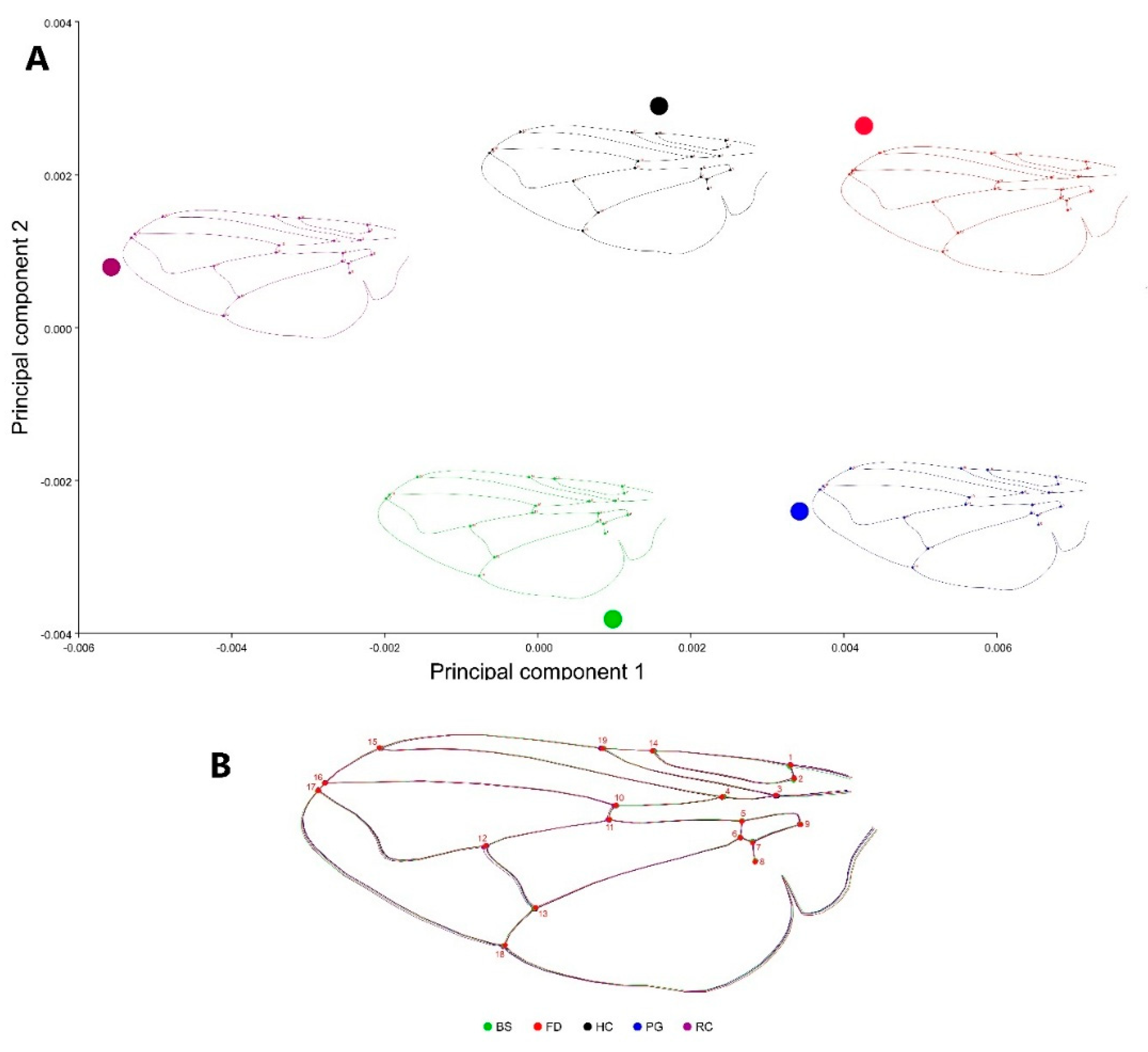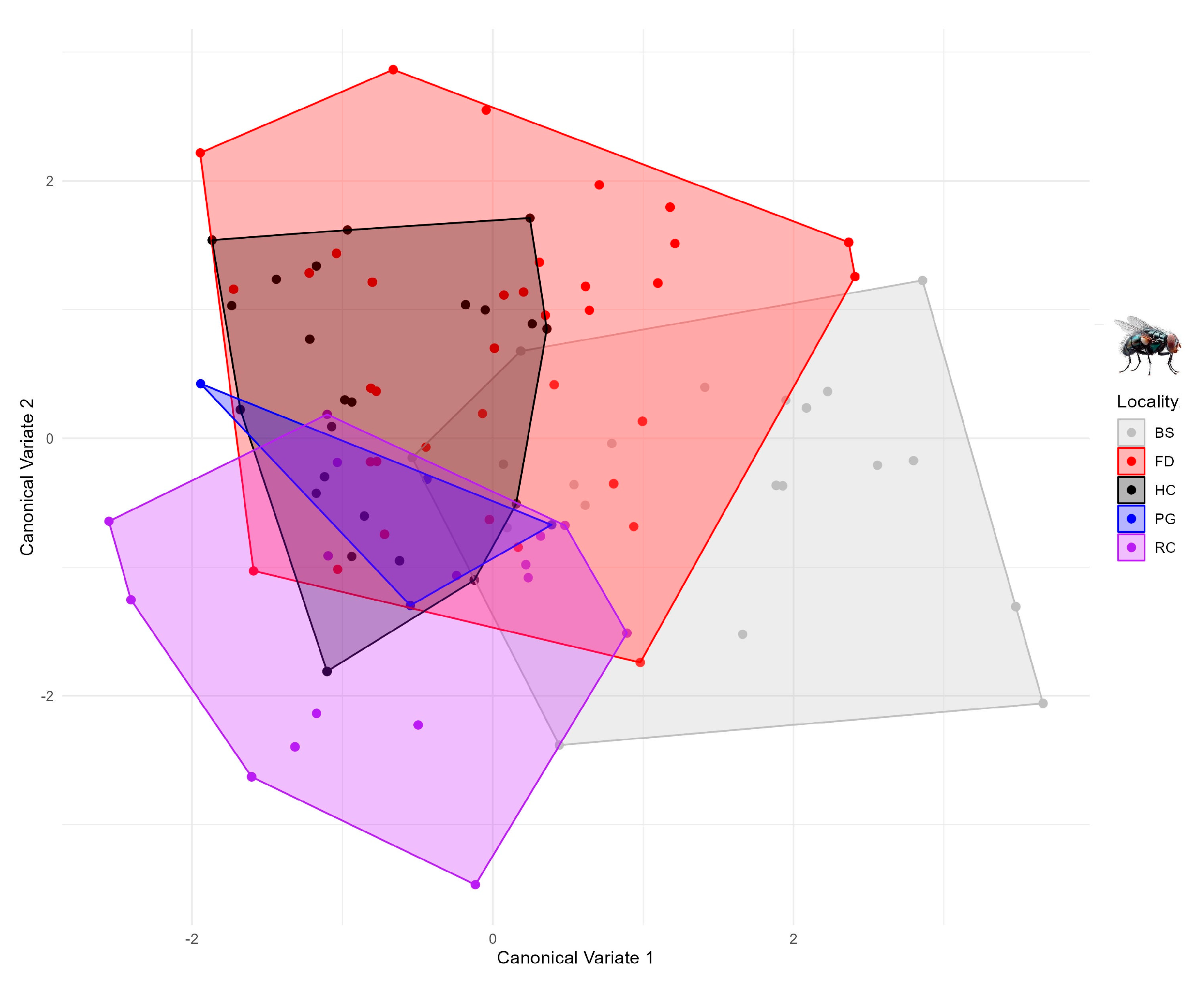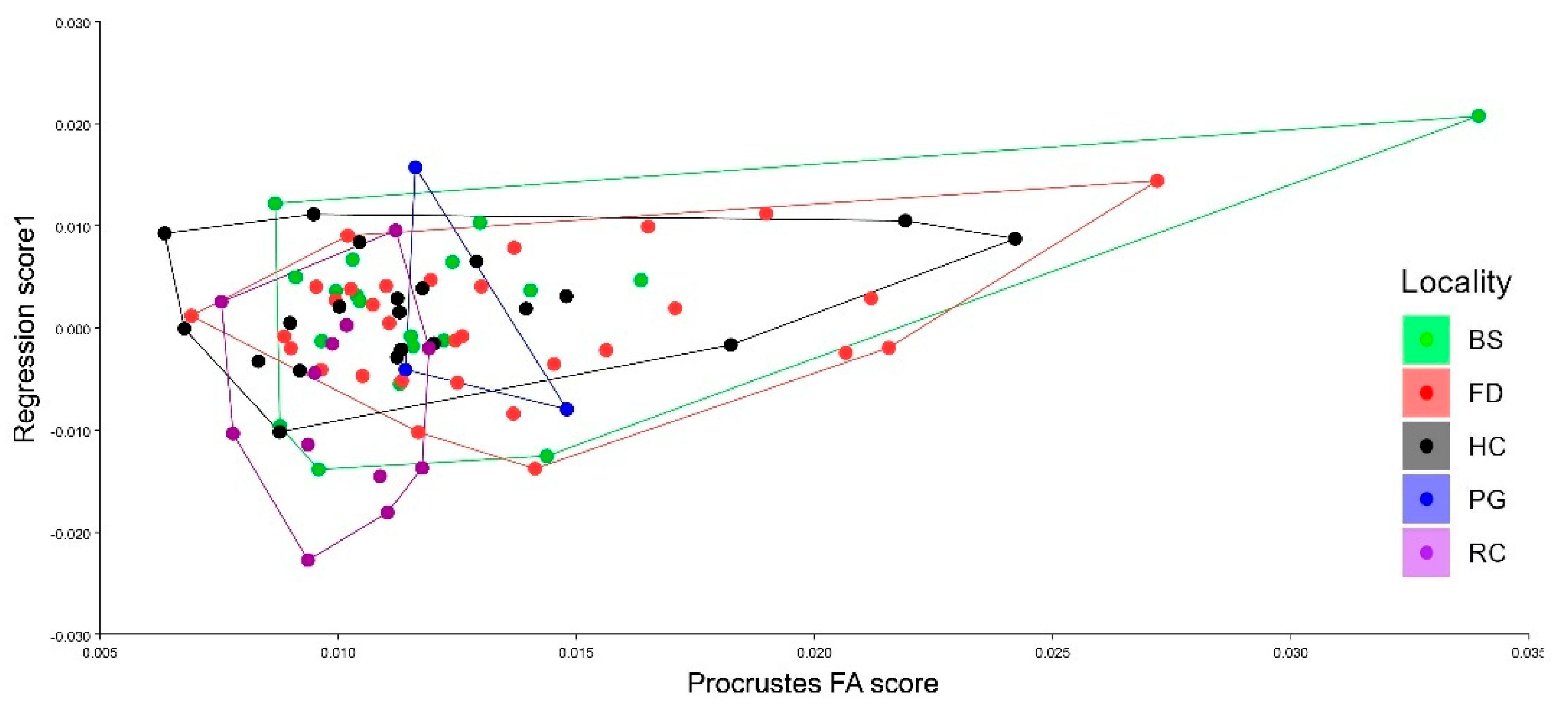Wing Shape Fluctuating Asymmetry in Flies: Insights into Environmental and Public Health Risk
Simple Summary
Abstract
1. Introduction
2. Materials and Methods
2.1. Data Acquisition
2.2. Geometric Morphometrics Analyses
3. Results
Fluctuating Asymmetry
4. Discussion
5. Conclusions
Author Contributions
Funding
Institutional Review Board Statement
Informed Consent Statement
Data Availability Statement
Acknowledgments
Conflicts of Interest
References
- Araya, J.E.; Ballesteros, C.; Curkovic, T. Control of Musca domestica L. adults with pyrethroid treatments applied to glass and wallpaper. J. Pestic. Sci. 2011, 36, 41–43. [Google Scholar] [CrossRef]
- Malik, A.; Singh, N.; Satya, S. House fly (Musca domestica): A review of control strategies for a challenging pest. J. Environ. Sci. Health Part B 2007, 42, 453–469. [Google Scholar] [CrossRef]
- Palacios, S.M.; Bertoni, A.; Rossi, Y.; Santander, R.; Urzúa, A. Efficacy of essential oils from edible plants as insecticides against the house fly, Musca domestica L. Molecules 2009, 14, 1938–1947. [Google Scholar] [CrossRef]
- Rodrigues, G.C.S.; dos Santos Maia, M.; Cavalcanti, A.B.S.; Barros, R.P.C.; Scotti, L.; Cespedes-Acuña, C.L.; Muratov, E.N.; Scotti, M.T. Computer-assisted discovery of compounds with insecticidal activity against Musca domestica and Mythimna separata. Food Chem. Toxicol. 2021, 147, 111899. [Google Scholar] [CrossRef]
- Chil-Núñez, I.; Mendonça, P.M.; Escalona-Arranz, J.C.; Dutok-Sánchez, C.M.; Bourzac, F.G.; Queiroz, M.M.d.C. Larvicide and insecticide activity of the essential oil of Ocimum sanctum var. cubensis in the control of Musca domestica (Linnaeus, 1758), under laboratory conditions. Amazon. Investig. 2020, 9, 24–33. [Google Scholar] [CrossRef]
- Nayduch, D.; Neupane, S.; Pickens, V.; Purvis, T.; Olds, C. House flies are underappreciated yet important reservoirs and vectors of microbial threats to animal and human health. Microorganisms 2023, 11, 583. [Google Scholar] [CrossRef]
- Nandi, N.K.; Vyas, A.; Akhtar, M.J.; Kumar, B. The growing concern of chlorpyrifos exposures on human and environmental health. Pestic. Biochem. Physiol. 2022, 185, 105138. [Google Scholar] [CrossRef] [PubMed]
- Kumar, P.; Arshad, M.; Gacem, A.; Soni, S.; Singh, S.; Kumar, M.; Yadav, V.K.; Tariq, M.; Kumar, R.; Shah, D. Insight into the environmental fate, hazard, detection, and sustainable degradation technologies of chlorpyrifos—An organophosphorus pesticide. Environ. Sci. Pollut. Res. 2023, 30, 108347–108369. [Google Scholar] [CrossRef]
- Zúñiga-Venegas, L.A.; Hyland, C.; Muñoz-Quezada, M.T.; Quirós-Alcalá, L.; Butinof, M.; Buralli, R.; Cardenas, A.; Fernandez, R.A.; Foerster, C.; Gouveia, N. Health effects of pesticide exposure in Latin American and the Caribbean populations: A scoping review. Environ. Health Perspect. 2022, 130, 096002. [Google Scholar] [CrossRef] [PubMed]
- McLachlan, A.J. Fluctuating asymmetry in flies, what does it mean? Symmetry 2010, 2, 1099–1107. [Google Scholar] [CrossRef]
- Moller, A.P. Sexual selection, viability selection, and developmental stability in the domestic fly Musca domestica. Evolution 1996, 50, 746–753. [Google Scholar] [CrossRef]
- Chapman, J.W.; Goulson, D. Environmental versus genetic influences on fluctuating asymmetry in the house fly, Musca domestica. Biol. J. Linn. Soc. 2000, 70, 403–413. [Google Scholar] [CrossRef]
- Birkemoe, T.; Soleng, A.; Aak, A. Biological control of Musca domestica and Stomoxys calcitrans by mass releases of the parasitoid Spalangia cameroni on two Norwegian pig farms. BioControl 2009, 54, 425–436. [Google Scholar] [CrossRef]
- Sparks, M.E.; Bansal, R.; Benoit, J.B.; Blackburn, M.B.; Chao, H.; Chen, M.; Cheng, S.; Childers, C.; Dinh, H.; Doddapaneni, H.V. Brown marmorated stink bug, Halyomorpha halys (Stål), genome: Putative underpinnings of polyphagy, insecticide resistance potential and biology of a top worldwide pest. BMC Genom. 2020, 21, 227. [Google Scholar] [CrossRef]
- Mougabure-Cueto, G.; Picollo, M.I. Insecticide resistance in vector Chagas disease: Evolution, mechanisms and management. Acta Trop. 2015, 149, 70–85. [Google Scholar] [CrossRef]
- Mikac, K.M.; Lemic, D.; Benítez, H.A.; Bažok, R. Changes in corn rootworm wing morphology are related to resistance development. J. Pest Sci. 2019, 92, 443–451. [Google Scholar] [CrossRef]
- Lardeux, F.; Depickère, S.; Duchon, S.; Chavez, T. Insecticide resistance of Triatoma infestans (Hemiptera, Reduviidae) vector of Chagas disease in Bolivia. Trop. Med. Int. Health 2010, 15, 1037–1048. [Google Scholar] [CrossRef] [PubMed]
- Shah, R.M.; Shad, S.A.; Abbas, N. Mechanism, stability and fitness cost of resistance to pyriproxyfen in the house fly, Musca domestica L. (Diptera: Muscidae). Pestic. Biochem. Physiol. 2015, 119, 67–73. [Google Scholar] [CrossRef]
- Gul, H.; Gadratagi, B.G.; Güncan, A.; Tyagi, S.; Ullah, F.; Desneux, N.; Liu, X. Fitness costs of resistance to insecticides in insects. Front. Physiol. 2023, 14, 1238111. [Google Scholar] [CrossRef]
- Ludoški, J.; Djurakic, M.; Pastor, B.; Martínez-Sánchez, A.; Rojo, S.; Milankov, V. Phenotypic variation of the housefly, Musca domestica: Amounts and patterns of wing shape asymmetry in wild populations and laboratory colonies. Bull. Entomol. Res. 2014, 104, 35–47. [Google Scholar] [CrossRef]
- Waddington, C.H. Canalization of development and the inheritance of acquired characters. Nature 1942, 150, 563–565. [Google Scholar] [CrossRef]
- Van Dongen, S. Fluctuating asymmetry and developmental instability in evolutionary biology: Past, present and future. J. Evol. Biol. 2006, 19, 1727–1743. [Google Scholar] [CrossRef]
- Polak, M. Developmental Instability: Causes and Consequences; Oxford University Press: Oxford, UK, 2003. [Google Scholar]
- Benítez, H.A.; Parra, L.E. Fluctuating Asymmetry: A Morpho-functional Tool to Measure Development Stability. Int. J. Morphol. 2011, 29, 1459–1469. [Google Scholar] [CrossRef]
- Moller, A.P. Developmental stability and fitness: A review. Am. Nat. 1997, 149, 916–932. [Google Scholar] [CrossRef]
- Klingenberg, C.P.; McIntyre, G.S. Geometric morphometrics of developmental instability: Analyzing patterns of fluctuating asymmetry with procrustes methods. Evolution 1998, 52, 1363–1375. [Google Scholar] [CrossRef]
- Klingenberg, C.P. Phenotypic plasticity, developmental instability, and robustness: The concepts and how they are connected. Front. Ecol. Evol. 2019, 7, 56. [Google Scholar] [CrossRef]
- Palmer, A.R.; Strobeck, C. Fluctuating Asymmetry—Measurement, Analysis, Patterns. Annu. Rev. Ecol. Syst. 1986, 17, 391–421. [Google Scholar] [CrossRef]
- Palmer, A.R. Fluctuating asymmetry analyses: A primer. In Developmental Instability: Its Origins and Evolutionary Implications; Springer: Berlin/Heidelberg, Germany, 1994; pp. 335–364. [Google Scholar]
- Zakharov, V.M.; Trofimov, I.E. Fluctuating asymmetry as an indicator of stress. Emerg. Top. Life Sci. 2022, 6, 295–301. [Google Scholar] [CrossRef]
- Klingenberg, C.P. Developmental instability as a research tool: Using patterns of fluctuating asymmetry to infer the developmental origins of morphological integration. In Developmental Instability: Causes and Consequences; Polak, M., Ed.; Oxford University Press: New York, NY, USA, 2003; pp. 427–442. [Google Scholar]
- Klingenberg, C. Analyzing Fluctuating Asymmetry with Geometric Morphometrics: Concepts, Methods, and Applications. Symmetry 2015, 7, 843–934. [Google Scholar] [CrossRef]
- Benítez, H.A.; Lemic, D.; Villalobos-Leiva, A.; Bažok, R.; Órdenes-Claveria, R.; Pajač Živković, I.; Mikac, K.M. Breaking Symmetry: Fluctuating Asymmetry and Geometric Morphometrics as Tools for Evaluating Developmental Instability under Diverse Agroecosystems. Symmetry 2020, 12, 1789. [Google Scholar] [CrossRef]
- Van Valen, L. A study of fluctuating asymmetry. Evolution 1962, 16, 125–142. [Google Scholar] [CrossRef]
- Graham, J.H.; Raz, S.; Hel-Or, H.; Nevo, E. Fluctuating asymmetry: Methods, theory, and applications. Symmetry 2010, 2, 466–540. [Google Scholar] [CrossRef]
- Parsons, P.A. Fluctuating asymmetry—A biological monitor of environmental and genomic stress. Heredity 1992, 68, 361–364. [Google Scholar] [CrossRef]
- Ribeiro, B.; Guedes, R.; Corrêa, A.; Santos, C. Fluctuating asymmetry in insecticide-resistant and insecticide-susceptible strains of the maize weevil, Sitophilus zeamais (Coleoptera: Curculionidae). Arch. Environ. Contam. Toxicol. 2007, 53, 77–83. [Google Scholar] [CrossRef]
- Nijhout, H.; Davidowitz, G. Developmental perspectives on phenotypic variation, canalization, and fluctuating asymmetry. In Developmental Instability: Causes and Consequences; Polak, M., Ed.; Oxford University Press: New York, NY, USA, 2003; pp. 3–13. [Google Scholar]
- Henríquez, P.; Donoso, D.S.; Grez, A.A. Population density, sex ratio, body size and fluctuating asymmetry of Ceroglossus chilensis (Carabidae) in the fragmented Maulino forest and surrounding pine plantations. Acta Oecologica 2009, 35, 811–818. [Google Scholar] [CrossRef]
- Benítez, H.A.; Briones, R.; Jerez, V. Intra and Inter-population morphological variation of shape and size of the Chilean magnificent beetle, Ceroglossus chilensis in the Baker River Basin, Chilean Patagonia. J. Insect Sci. 2011, 11, 94. [Google Scholar] [CrossRef][Green Version]
- Zverev, V.; Kozlov, M.V. The fluctuating asymmetry of the butterfly wing pattern does not change along an industrial pollution gradient. Symmetry 2021, 13, 626. [Google Scholar] [CrossRef]
- Szentgyörgyi, H.; Czekońska, K.; Tofilski, A. Influence of pollen deprivation on the fore wing asymmetry of honeybee workers and drones. Apidologie 2016, 47, 653–662. [Google Scholar] [CrossRef]
- Arce, A.N.; Cantwell-Jones, A.; Tansley, M.; Barnes, I.; Brace, S.; Mullin, V.E.; Notton, D.; Ollerton, J.; Eatough, E.; Rhodes, M.W. Signatures of increasing environmental stress in bumblebee wings over the past century: Insights from museum specimens. J. Anim. Ecol. 2023, 92, 297–309. [Google Scholar] [CrossRef]
- Friedli, A.; Williams, G.R.; Bruckner, S.; Neumann, P.; Straub, L. The weakest link: Haploid honey bees are more susceptible to neonicotinoid insecticides. Chemosphere 2020, 242, 125145. [Google Scholar] [CrossRef] [PubMed]
- Muñoz-Quezada, M.T.; Pasten, P.; Landeros, N.; Valdés, C.; Zúñiga-Venegas, L.; Castillo, B.; Lucero, B.; Castillo, A.; Buralli, R.J. Bioethical Analysis of the Socio-Environmental Conflicts of a Pig Industry on a Chilean Rural Community. Sustainability 2024, 16, 5457. [Google Scholar] [CrossRef]
- Muñoz-Quezada, M.T.; Iglesias, V.; Zúñiga-Venegas, L.; Pancetti, F.; Foerster, C.; Landeros, N.; Lucero, B.; Schwantes, D.; Cortés, S. Exposure to pesticides in Chile and its relationship with carcinogenic potential: A review. Front. Public Health 2025, 13, 1531751. [Google Scholar] [CrossRef] [PubMed]
- Muñoz-Quezada, M.T.; Lucero, B.; Bradman, A.; Steenland, K.; Zúñiga, L.; Calafat, A.M.; Ospina, M.; Iglesias, V.; Muñoz, M.P.; Buralli, R.J. An educational intervention on the risk perception of pesticides exposure and organophosphate metabolites urinary concentrations in rural school children in Maule Region, Chile. Environ. Res. 2019, 176, 108554. [Google Scholar] [CrossRef] [PubMed]
- Fruciano, C. Measurement error in geometric morphometrics. Dev. Genes Evol. 2016, 226, 139–158. [Google Scholar] [CrossRef]
- Arnqvist, G.; Martensson, T. Measurement error in geometric morphometrics: Empirical strategies to assess and reduce its impact on measures of shape. Acta Zool. Acad. Sci. Hung. 1998, 44, 73–96. [Google Scholar]
- Rohlf, F.J.; Slice, D. Extensions of the Procustes methods for the optimal superimposition of landmarks. Syst. Zool. 1990, 39, 40–59. [Google Scholar] [CrossRef]
- Jolliffe, I.T. Principal Component Analysis, 2nd ed.; Springer: New York, NY, USA, 2002. [Google Scholar]
- Eeva, T.; Tanhuanpää, S.; Råbergh, C.; Airaksinen, S.; Nikinmaa, M.; Lehikoinen, E. Biomarkers and fluctuating asymmetry as indicators of pollution-induced stress in two hole-nesting passerines. Funct. Ecol. 2000, 14, 235–243. [Google Scholar] [CrossRef]
- Vangestel, C.; Lens, L. Does fluctuating asymmetry constitute a sensitive biomarker of nutritional stress in house sparrows (Passer domesticus)? Ecol. Indic. 2011, 11, 389–394. [Google Scholar] [CrossRef]
- Zakharov, V.M.; Shadrina, E.G.; Trofimov, I.E. Fluctuating asymmetry, developmental noise and developmental stability: Future prospects for the population developmental biology approach. Symmetry 2020, 12, 1376. [Google Scholar] [CrossRef]
- Shadrina, E.; Pertoldi, C. Fluctuating Asymmetry as a Measure of Stress: Influence of Natural and Anthropogenic Factors. Symmetry 2024, 16, 539. [Google Scholar] [CrossRef]
- Polak, M.; Opoka, R.; Cartwright, I.L. Response of fluctuating asymmetry to arsenic toxicity: Support for the developmental selection hypothesis. Environ. Pollut. 2002, 118, 19–28. [Google Scholar] [CrossRef]
- Benítez, H.A.; Lemic, D.; Püschel, T.A.; Gašparić, H.V.; Kos, T.; Barić, B.; Bažok, R.; Živković, I.P. Fluctuating asymmetry indicates levels of disturbance between agricultural productions: An example in Croatian population of Pterostichus melas melas (Coleptera: Carabidae). Zool. Anz. 2018, 276, 42–49. [Google Scholar] [CrossRef]
- Vilaseca, C.; Méndez, M.A.; Pinto, C.F.; Benítez, H.A. Assessment of Shape Variation Patterns in Triatoma infestans (Klug 1834)(Hemiptera: Reduviidae: Triatominae): A First Report in Populations from Bolivia. Insects 2020, 11, 274. [Google Scholar] [CrossRef] [PubMed]
- Floate, K.; Fox, A. Flies under stress: A test of fluctuating asymmetry as a biomonitor of environmental quality. Ecol. Appl. 2000, 10, 1541–1550. [Google Scholar] [CrossRef]
- Clarke, G.M.; Ridsdill-Smith, T. The effect of avermectin B1 on developmental stability in the bush fly, Musca vetustissima, as measured by fluctuating asymmetry. Entomol. Exp. Et Appl. 1990, 54, 265–269. [Google Scholar] [CrossRef]






| Zone | Code | Distance to Centre (m) | Distance to Forestry (m) | Distance to Forestry 2 (m) |
|---|---|---|---|---|
| Zone 1 | HC | 8798 | 5897 | 6806 |
| Zone 2 | RC | 5702 | 7677 | 7651 |
| Zone 3 | PG | 3235 | 2312 | 3001 |
| Zone 4 | BS | 9113 | 6220 | 7114 |
| Zone 5 | FD | 3160 | 2821 | 1873 |
Disclaimer/Publisher’s Note: The statements, opinions and data contained in all publications are solely those of the individual author(s) and contributor(s) and not of MDPI and/or the editor(s). MDPI and/or the editor(s) disclaim responsibility for any injury to people or property resulting from any ideas, methods, instructions or products referred to in the content. |
© 2025 by the authors. Licensee MDPI, Basel, Switzerland. This article is an open access article distributed under the terms and conditions of the Creative Commons Attribution (CC BY) license (https://creativecommons.org/licenses/by/4.0/).
Share and Cite
Benítez, H.A.; Oróstica-Pinochet, R.; Suazo, M.J.; Pérez, L.M.; Hernández-Martelo, J.; Valdes, C.; Muñoz-Quezada, M.T.; Correa, M. Wing Shape Fluctuating Asymmetry in Flies: Insights into Environmental and Public Health Risk. Animals 2025, 15, 3124. https://doi.org/10.3390/ani15213124
Benítez HA, Oróstica-Pinochet R, Suazo MJ, Pérez LM, Hernández-Martelo J, Valdes C, Muñoz-Quezada MT, Correa M. Wing Shape Fluctuating Asymmetry in Flies: Insights into Environmental and Public Health Risk. Animals. 2025; 15(21):3124. https://doi.org/10.3390/ani15213124
Chicago/Turabian StyleBenítez, Hugo A., Rocío Oróstica-Pinochet, Manuel J. Suazo, Laura M. Pérez, Jordan Hernández-Martelo, Cristian Valdes, María Teresa Muñoz-Quezada, and Margarita Correa. 2025. "Wing Shape Fluctuating Asymmetry in Flies: Insights into Environmental and Public Health Risk" Animals 15, no. 21: 3124. https://doi.org/10.3390/ani15213124
APA StyleBenítez, H. A., Oróstica-Pinochet, R., Suazo, M. J., Pérez, L. M., Hernández-Martelo, J., Valdes, C., Muñoz-Quezada, M. T., & Correa, M. (2025). Wing Shape Fluctuating Asymmetry in Flies: Insights into Environmental and Public Health Risk. Animals, 15(21), 3124. https://doi.org/10.3390/ani15213124









